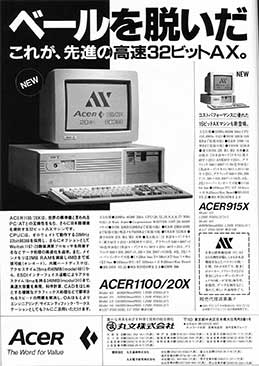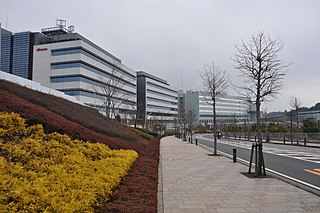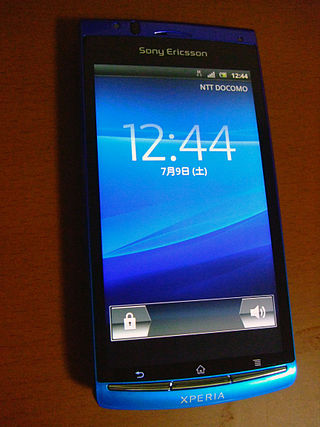
Walkman, stylised as WALKMAN (ウォークマン), is a brand of portable audio players manufactured and marketed by Japanese company Sony since 1979. The original Walkman started out as a portable cassette player and the brand was later extended to serve most of Sony's portable audio devices; since 2011 it consists exclusively of digital flash memory players. The current flagship product as of 2022 is the WM1ZM2 player.
Sony Mobile Communications Inc. was a multinational telecommunications company founded on October 1, 2001, as a joint venture between Sony Corporation and Ericsson. It was originally incorporated as Sony Ericsson Mobile Communications, and headquartered in London, England, until Sony acquired Ericsson's share in the venture on February 16, 2012. On April 1, 2021, Sony integrated its electronics businesses including Sony Mobile into one company called Sony Corporation.

KDDI Corporation is a Japanese telecommunications operator. It was established in 2000 through the merger of DDI, KDD (ケイディディ), and IDO. In 2001, it merged with a subsidiary named Au, which was formed through the merger of seven automotive and mobile phone companies from the DDI-Cellular Group. As of 2020, it is the second-largest mobile telecommunications provider in Japan in terms of the number of contracts, following NTT Docomo.

Sanyo Electric Co., Ltd. is a Japanese electronics manufacturer founded in 1947 by Toshio Iue, the brother-in-law of Kōnosuke Matsushita, the founder of Panasonic. Iue left Matsushita Electric Industrial to start his own business, acquiring some of its equipment to produce bicycle generator lamps. In 1950, the company was established. Sanyo began to diversify in the 1960s, launching Japan's first spray-type washing machine in 1953. In the 2000s, it was known as one of the 3S along with Sony and Sharp. Sanyo also focused on solar cell and lithium battery businesses. In 1992, it developed the world's first hybrid solar cell, and in 2002, it had a 41% share of the global lithium-ion battery market. In its heyday in 2003, Sanyo had sales of about ¥2.5 trillion. However, it fell into a financial crisis as a result of its huge investment in the semiconductor business. In 2009, Sanyo was acquired by Panasonic, and in 2011, it was fully consolidated into Panasonic and its brand disappeared. The company still exists as a legal entity for the purpose of winding up its affairs.

SonicStage is a discontinued software product from Sony that is used for managing portable devices when they are plugged into a computer running Microsoft Windows. It comprises a music player and library manager, similar to iTunes, Windows Media Player and RealPlayer. It is used to manage the library of ATRAC and MP3 recordings on a PC.

au, or au by KDDI, is a Japanese mobile phone operator. au is a brand marketed by KDDI in the main islands of Japan and by Okinawa Cellular in Okinawa for their mobile cellular services. au is the second-largest wireless carrier in Japan, with 60.398 million subscribers as of March 2021.

The Japanese electronics industry is one of the largest in the world, though the share of Japanese electronics companies has significantly declined from its peak due to competition from South Korea, Taiwan, China, and the United States.

The W800 Walkman, released in 2005, was the first Sony Ericsson phone to use the Walkman brand. The phone features Bluetooth v1.2, Infrared and USB connectivity.
1seg is a mobile terrestrial digital audio/video and data broadcasting service in Japan, Argentina, Brazil, Chile, Uruguay, Paraguay, Peru and the Philippines. Service began experimentally during 2005 and commercially on April 1, 2006. It is designed as a component of ISDB-T, the terrestrial digital broadcast system used in those countries, as each channel is divided into 13 segments, with a further segment separating it from the next channel; an HDTV broadcast signal occupies 12 segments, leaving the remaining (13th) segment for mobile receivers, hence the name, "1seg" or "One Seg".

AX was a Japanese computing initiative starting in around 1986 to allow PCs to handle double-byte (DBCS) Japanese text via special hardware chips, whilst allowing compatibility with software written for foreign IBM PCs.

The Sony Ericsson W850i is the first 3G slider mobile phone by Sony Ericsson, introduced in Q2 2006. It is a member of their Walkman line, suceeding the Sony Ericsson W600. The phone made its first public appearance in the 2006 movie The Da Vinci Code, months before its release. It is similar mechanically to the Sony Ericsson K800i{{cn}}, but differs in form factor, use of the Memory Stick PRO Duo instead of the Memory Stick Micro, and camera quality.

Yokosuka Research Park (YRP) is an area in Yokosuka City, Japan, where many of the wireless, mobile communications related companies have set up their research and development centers and joint testing facilities.
Sony Mobile Display Corporation was a subsidiary of Sony Corporation and produced Low-temperature polysilicon, amorphous silicon TFT LCD panels, organic EL displays and touch screens for use in mobile products such as camcorders, digital cameras, mobile phones, automobiles, etc. Its manufacturing plants were located in Higashiura, Aichi and Tottori, Tottori, Japan. The business of the company was transferred to Japan Display Inc. on April 1, 2012.

Sony Ericsson W205 is an entry-level dual-band GSM/GPRS Walkman phone with a focus on music playback. It was announced on 7 April 2009 under the marketing tag 'your first Walkman phone'. The phone was available in black, white, pink and blue.

The Japanese mobile phone industry is one of the most advanced in the world. As of March, 2022 there were 199.99 million mobile contracts in Japan according to the Ministry of Internal Affairs and Communications. This is 158 percent of Japan's total population.

The Sony Ericsson Xperia acro is an Android-based smartphone produced by Sony Ericsson Mobile Communications in Japan. The device has several additional functions for Japan customers from Xperia Arc. It was launched on 24 June 2011.













